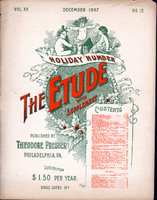BY JOHN C. GRIGGS.
Through all the confusion that obtains in regard to the terminology of vocal study, a certain general distinction exists in the minds of all between method and style. Method, I believe, is generally accepted as designating the study of tone-production in its various phases; in its relation to the physical means to be employed and physical obstacles to be met. It also designates the cultivation of the mental and temperamental sensitiveness of the singer to the tremendous value of ideal tone as an original and powerful musical moment, quite apart from musical construction. Method of study, I may say, is at once the perfecting of the instrument and the stimulating of the student’s mind to an all-compelling search and passion for that primal element—ideal tone.
Style, we should all agree, is the use of this trained instrument and this quickened mentality in that form of musical construction which is called rendition. Strictly considered, it does not reach so far as interpretation. It covers the use of every resource of the human voice. A blemish in method causes a limitation in style, just as a blemish in style causes a limitation of the singer in the power of interpretation. No one feature, unless we except perfect intonation, is so continually necessary to good style as legato. Legato is that “binding together” of note to note in the phrase, of word to word in the song, which makes upon the hearer the impression of continuous melody, and gives him the sense of song. The mechanics of the legato on the piano is easily understood, even though its acquisition and control is so extremely difficult for the player. There it is simply a question of continuity ; of continuing the one tone until the very instant of the creation of the next; of not allowing any smallest interval of silence to occur. It would require the nicest discrimination to observe it mathematically, yet the ear recognizes it musically with the utmost ease.
But is this absence of the instant of silence a sufficient definition of legato for the singer? Decidedly not. The greater part of the non-legato singing we hear is not detached singing. Clearly, the lack of continuity with the singer does not consist in the interstices of silence between successive tones, as in the case of the faulty pianist. There is something in the first note of the artist’s song which sometimes gives us a certainty of prospective legato. We even feel, sometimes, that thrilling sense of legato, reaching with magnetic power across the silence of a long dramatic pause or the taking of a deliberate breath.
The absence of legato, then, may arise not only from mere bold stopping between one tone and the next, but does arise, in singing, most often from changes of pitch, of quality, and of power. The first phase of legato study, then, is a study of attack; for faulty attack is usually fluctuation of pitch. To begin a tone always at its exact pitch, in spite of all distractions of consonant, vowel, or musical phrase, is no small matter. To accomplish this marks no small acquirement of vocal method. A still closer dependence of legato—and of its other self, attack—upon method, is in producing continuity of quality. How many times do we hear the desired quality of tone in the student’s voice long before the student has the power to produce it fully and clearly and squarely in the attack! And so of power. I have been struggling this season with the case of a singer of good voice and temperament, many excellent points of method, and some particulars of a beautiful style, yet whose every phrase is <><><>. Attack is always good as to pitch and usually as to quality, but never as to power. There is no slovenliness of articulation; i. e., every consonant is pronounced fully, except that mere tonal power is constantly changing. And here the result is absolute non-legato, even though, in this particular instance, the singer gives a conscientious and caressing attention to every instant and allows no slightest pause.
All that has been said of attack in relation to legato applies conversely to sostenuto, and thus it is seen that legato, the prime requisite of style, demands and exhausts the utmost technic which method can suggest and train.
Because of this dependence of style upon method, no teaching of method can be complete which does not continually, and from the outset, keep before the student’s mind the demands of pure style. In regard to interpretation, it may be different, for there the larger ideas must be gleaned from the whole field of the world’s music; but the teacher of method who fails to assert himself as a master of style finds his efforts in what he circumscribes as “simply tone-production” to be of little lasting result in the life of the singer. For him so to limit the scope of his effort is not only to hide his light under a bushel, but to crawl ignominiously under the basket himself, and in the roomy dimness which he there perceives to gaze upon that light until verily it goeth out.



